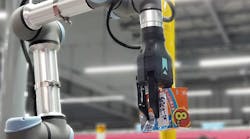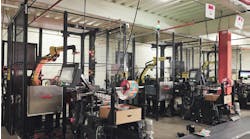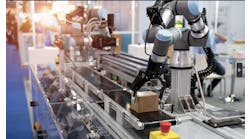Vince Martinelli is head of product and marketing at RightHand Robotics. Throughout his career, Martinelli has helped introduce new technologies and products into challenging, large-scale applications for telecommunications, aerospace, automotive, e-commerce and electric power utility customers worldwide. He earned his bachelor of science and master of science degrees from MIT in materials science and engineering, with a concentration in economics. At MIT, he was a Tau Beta Pi fellow and an Academic All American athlete.
What sorts of sensing technologies have improved the effectiveness and reliability of picking systems and conveyance systems?
Vince Martinelli, head of product and marketing, RightHand Robotics: The critical sensing technology has clearly been the availability of cameras with the performance needed to meet the application use-case needs. We’ve been working with Intel as a supplier for the past few years, using the Intel RealSense D415 Depth Camera.
Also read: Warehouse automation with the human touch
As warehouse distribution centers continue to grow larger, how are tracking and intelligence helping to keep up with customer demands?
Vince Martinelli, head of product and marketing, RightHand Robotics: Well, they are already pretty large, with e-commerce fulfillment centers being as large as 1 million square feet—roughly 22 football fields of area under one roof. But the number is growing, while in parallel there is a new trend toward micro-fulfillment centers (MFCs) that can fit in the footprint of a typical grocery store, for example. The technology that used to only make financial sense in giant buildings is now also cost-effective at the smaller scale. This allows product distribution nodes to be positioned closer to customer population centers and simplifies last-mile deliveries. As this overall suite of distribution centers and the delivery networks that connect them to customers evolve, handling and tracking products one item at a time become much more critical than traditional models for store replenishment. It is more than just one technology or one product, but solutions like autonomous piece-picking robots provide a lot of flexibility as these new networks emerge.
Which technologies have allowed warehouses to increase throughput rates while expanding product ranges and still maintaining accurate order fulfillment?
Vince Martinelli, head of product and marketing, RightHand Robotics: You have to start with critical software systems like warehouse management (WMS), for example. It’s really impossible to run a modern ecommerce fulfillment operation without it. The complexity and scope can be overwhelming for manual systems, once your business reaches a certain size. After that, the combination of automation and robotic systems, married with advanced warehouse software systems, depends a lot on the type of products—consumer packaged goods or kayaks, the order profiles from customers, like whether they order one item at a time or 50, and the delivery service area. In addition to basic software systems, the availability of cloud resources and high-speed communications networks provide near-real-time visibility throughout the network. These capabilities have evolved rapidly over the past five to 10 years. The challenges include how to future-proof the system as the technology races forward. It pays for retailers to think their strategy through with this rate of technology change in mind.
Because of the warehouse’s physical nature, how much of the facility’s hardware can be replaced with software in order to facilitate easier upgrades, expansions and reconfigurations?
Vince Martinelli, head of product and marketing, RightHand Robotics: It’s not an either/or situation. A well-designed, modern warehouse is built on a combination of hardware and software systems. You can think of it like some type of ocean liner, where you want to have control and visibility from the bridge to manage the engines and course, but you absolutely need top-notch physical systems and a disciplined crew, too. Automated systems should make it easier to manage the entire system, alleviating the crew from more mundane, difficult or dangerous work, which potentially means you can deliver the same freight over the ocean with fewer people. It’s an analogy, but it isn’t too far off. It’s hard to replace hardware completely with software, and you do have to be careful that the hardware platform is capable of accepting new software updates over time. This is another mechanism for improving performance over time, as well as refining the processes that the staff uses. It is always a combination of all three assets: the hardware, software and team.
How have automated storage and retrieval systems' roles changed over the past 10 years?
Vince Martinelli, head of product and marketing, RightHand Robotics: In the early generation of these systems, they tended to lack an “any to any” capability, by which I mean not every product in inventory could be presented to every pick station.
Think about early carousel-style systems, for example, which worked on the same basic idea as the system used at your local dry cleaners. One limitation is how many items can fit in the system, before you need a parallel one. Immediately you realize you probably need two different people picking from two different positions to access every item. Each person also waits for a lot of inventory to cycle by before the correct item is presented.
Early ASRS helped with this second challenge, as totes could be presented rapidly in a steady stream of only the items being ordered right now, but they often did not have the ability for the shuttle bots to traverse between pick stations. Systems like the mobile fulfillment system pioneered by Kiva Systems and the AutoStore cube storage ASRS changed the paradigm. You could bring any SKU to any pick station directly at any time. Among other things, this means you could pick complete orders with only one person working, versus having to batch-pick and sort to orders in a second downstream process.
These modern systems also involve software algorithms to optimize the efficiency of the robot fleet and prioritize product movement for orders that need to meet a particular service-level agreement, such as next-day customer delivery. And, of course, they integrate intelligently with WMS and WES in the facility.
Even more recently, we have seen the emergence of versions of ASRS that are cost-effective even at small scale for use in MFC designs. We are just starting to see how this will change ecommerce fulfillment over the next five to 10 years, but it is going to make new business models possible and have a big impact on retail overall.
Will autonomous mobile robots replace automated guided vehicles altogether, or is there room for both, based on the application or complementary functions?
Vince Martinelli, head of product and marketing, RightHand Robotics: If you can’t tell yet, I’m kind of a “both” person. AMR deployments will continue to grow as people value the flexibility, reconfigurability and even portability of these systems. That’s a strong trifecta of “abilities.” AGVs will still play a role when the process is well-defined and likely to remain fixed for long periods of time. Moving pallets of beer at a large brewery over to the shipping area, for example, might be great for AGVs. They will be simpler, in many ways, but less flexible as a tool for building advanced fulfillment or even manufacturing processes. So, I’m more bullish on the near-term growth rate for AMRs but expect some complementary use cases for both types of systems in the long run.
How will ANSI/RIA R15.08 affect robotic solutions in warehouse environments?
Vince Martinelli, head of product and marketing, RightHand Robotics: To be clear, our business is focused on stationary, robotic picking systems. Essentially, we bring autonomous item-handling capabilities to that port on the ASRS, for example. Our robot sees and picks the SKU from the inventory tote and places directly to the outbound container on some form of conveyor. So, we do not have an official opinion on the mobile robot standards. In general, I will say that the development of standards almost always implies enough of a market activity and need to justify the effort. It also, from what I have observed over time, and as a former chairman of a standards committee, can be very helpful in driving common understanding between buyers and sellers of AMR and AGV systems, so that expectations can be met for intended applications. I believe that all of this is good for robots in warehouses in the long run.
Given the extraordinary percentage of manual operation in most distribution centers, will the 24/7 fully autonomous warehouse order-fulfillment center ever become commonplace?
Vince Martinelli, head of product and marketing, RightHand Robotics: Never say never, but it depends a lot on the nature of the warehouse. For everyday goods-to-person ecommerce operations, there will still be many manual positions for a long time. Even an extremely advanced and intelligent system can only execute the simpler warehouse tasks and workflows. AMRs and modern ASRS certainly help reduce the level of effort by the people collaborating with them but still require interaction with humans. So, directionally, we will continue to see the trend where people in the facility leverage automation to achieve higher productivity, more capacity in the same space or with the same sized crew and more responsiveness to customer needs, but it remains a game where the people and the bots work together for the best win.






